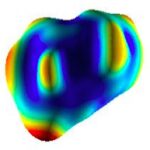Lien vers Pubmed [PMID] – 21193379
IEEE Trans Image Process 2011 Jul;20(7):1925-37
Variational deformable models have proven over the past decades a high efficiency for segmentation and tracking in 2-D sequences. Yet, their application to 3-D time-lapse images has been hampered by discretization issues, heavy computational loads and lack of proper user visualization and interaction, limiting their use for routine analysis of large data-sets. We propose here to address these limitations by reformulating the problem entirely in the discrete domain using 3-D active meshes, which express a surface as a discrete triangular mesh, and minimize the energy functional accordingly. By performing computations in the discrete domain, computational costs are drastically reduced, whilst the mesh formalism allows to benefit from real-time 3-D rendering and other GPU-based optimizations. Performance evaluations on both simulated and real biological data sets show that this novel framework outperforms current state-of-the-art methods, constituting a light and fast alternative to traditional variational models for segmentation and tracking applications.





